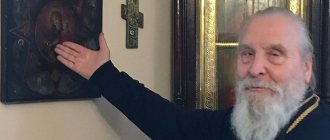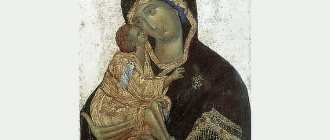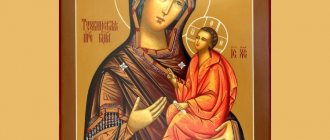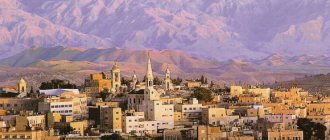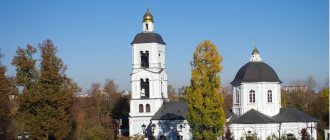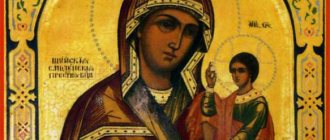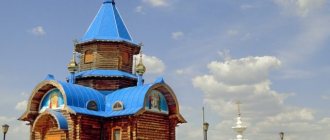Gethsemane Shroud of the Mother of God and pilgrimage relics associated with it. S.V. Gnutova
In many churches and monasteries in Russia you can see small wooden flat figures carved along the contour, which depict the reclining Mother of God with her eyes closed and her hands folded on her chest. As a rule, such figures are painted with colored paints only on the front side, often decorated with beaded embroidered chasubles, and on the reverse there are inscriptions and stamps (ink seals). Most of the surviving images of the Mother of God can be dated, according to the style and signatures on the reverse side, to the second half of the 19th - early 20th centuries. Where were such contour figures made, and why did they become so widespread in Russia in the 19th century?
Let us list some of the inscriptions placed on the back of these small wooden shrouds. On one of them we find an ink inscription with the following content: “Blessing from the Sepulcher of the Mother of God of Gethsemane, rector of the monastery Archimandri (t) Macarius '1889'.” On the back side of the Mother of God’s halo there is a paper seal with the image of the Assumption of the Mother of God and the Greek inscription “Tomb of the Mother of God. Gethsemane”, made in a circle. On the other, larger figure, on the back there are three oval-shaped ink stamps with the inscription “Blessing of St. city of Jerusalem)). Another figure of the Mother of God inserted into the Assumption icon has a seal in an oval on the reverse:
“Blessing of the Holy Mount of Olives to the Women’s Community in Jerusalem”[1]. The above inscriptions indicate the origin of these shrouds from the holy city of Jerusalem.
All known images of the Mother of God on wooden shrouds are extremely similar and clearly go back to the same prototype. This iconographic example has survived to this day and is located in Jerusalem in the courtyard of the Gethsemane monastery, the so-called Little Gethsemane, located opposite the entrance to the Church of the Holy Sepulchre. In this small church, on the right side of the altar, the shroud of the Blessed Virgin Mary is kept. She rests in front of the revered icon of the Mother of God the Merciful, decorated with several rows of monistas and decorations on the occasion of numerous healings from her. We find a detailed description of the shroud itself and its location from Archimandrite Leonid (Kavelin): “The Gethsemane courtyard <...> occupies the southern side of the square that was once under the porticoes of St. Coffin. The abbot of the Gethsemane underground temple and several of his assistant novices live here. There is a small flower garden on the open terrace of the second tier; next to the abbot's cell there is a small paraklis (church), in which the icon of the Dormition of the Mother of God has a permanent location, which is annually solemnly transferred from here on the eve of the feast of the Dormition of the Mother of God to Gethsemane in honor of this great feast. This icon represents a figure of the Mother of God carved along the contour, reclining in a tomb, and is lined with a silver-gilded frame on both sides; the crown is decorated with precious stones; there are quite a few extras. The chasuble on it is a gift from the Russian Melanie, Countess Anna Alekseevna Orlova-Chesmenskaya”[2].
And here is how A. A. Dmitrievsky, who attended the festival in honor of the Dormition of the Mother of God in Jerusalem in the summer of 1898, describes the shroud: “The days of the Dormition Fast, closest to the Feast of the Transfiguration and immediately following it until the 12th of August, attract the attention of pilgrims to the wretched and the small chapel of the Gethsemane courtyard (metoch), located inside the walls of Jerusalem, opposite the entrance doors leading to the Church of the Resurrection. The shroud with the image of the Dormition of St. is usually kept here. Theotokos, used by the Zion Church during the solemn service on the Feast of the Assumption. This shroud represents an image of the Mother of God, on a board an arshin and a quarter or an arshin and a half long, girded with a silver swaddling cloth, or burial shrouds from the neck to the feet, shod with silver sandals. The open face of the Mother of God, painted artistically, is surrounded by a halo embroidered in gold. This shroud rests here in front of the icon of the Most Merciful Mother of God on a special bed, surrounded by candlesticks, on which candles, lit by the zeal of the pilgrims, burn inextinguishably. Near this shroud, on the days described, paraklis-prayer services and akathists are served from morning until late at night, and at three o’clock in the afternoon Vespers is celebrated.”[3]. A. A. Dmitrievsky notes that the richly decorated shroud of the Mother of God, used during the Assumption celebrations in Jerusalem, is “the fruit of the zeal of Countess A. A. Orlova-Chesmenskaya”[4].
The maid of honor of the court of His Imperial Majesty, Countess Anna Alekseevna Orlova-Chesmenskaya, daughter of Count Alexei Orlov, one of the richest people in Russia, became famous for her charitable deeds and numerous contributions to churches and monasteries in Russia, as well as abroad. She was involved in the beautification of such monasteries as the Yuriev Monastery in Novgorod, the Kiev Pechersk Lavra[5] and the St. Michael's Golden-Domed Monastery[6]. The iconostasis of the St. Nicholas Church in Cairo[7] and others was completed at the expense of the countess.
One of the contributions of Countess A. A. Orlova-Chesmenskaya, apparently, was a wooden shroud of the Mother of God, decorated with a luxurious chased silver chasuble and precious stones. It can be assumed that the shroud was placed in the Jerusalem courtyard of the Gethsemane monastery no later than the 1840s, since the countess died suddenly on October 5, 1848. It has not yet been possible to establish a more precise date for the deposit. But it was from the middle of the 19th century that copies of the Shroud of Gethsemane began to appear in Russia.
One of the earliest surviving copies of this particular carved wooden shroud, as well as the beautiful box with carved gilded baroque ornaments on which it rests, can be seen in the 1868 icon, currently kept in the collection of the State Museum of the History of Religion in St. -Petersburg. At the bottom of the icon there is an inscription: “Written in the Holy City of Jerusalem in 1868”[8].
There is earlier written evidence of the appearance of a revered copy of the Shroud of Gethsemane in Russia, which can be dated back to the late 1850s. Thus, Archimandrite Leonid (Kavelin), describing his stay in Jerusalem in 1858–1859, and, in particular, the feast of the Dormition of the Mother of God in Gethsemane, draws attention to a good copy of the shroud, which “those who wish can see in the Anosin nunnery, located in Zvenigorod district; it was brought as a gift to this monastery by one of the Russian pilgrims, accepted with faith and reverently honored by the monastery and its visitors; This icon is richly decorated by the zeal of one of the monastery’s benefactors”[9].
Let us turn to the pre-revolutionary inventory of the Boris-Gleb Anosin Monastery[10]. In the refectory part of the cathedral church of the Life-Giving Trinity in the chapel in honor of the Dormition of the Mother of God in the pre-altar iconostasis: “Next to the northern door is the icon of the Dormition of the Mother of God, which, by order of His Eminence Metropolitan Philaret, is cut into a board, on a bed, Greek scripture, the height of the board is two arshins, the width is one arshin ten vershoks. The very icon of the Mother of God was donated by the nun of the Saratov Holy Cross Monastery Maria Lyubarskaya, and she exchanged it from the Holy City of Jerusalem.
The robe on the icon is silver-gilded, chased work, 84 standard, weighing in silver thirty-four pounds forty-eight spools, priced at twenty kopecks per spool; the image of the soul of the Mother of God is set with small and medium pearls, weighing seven spools, its value is approximately twenty rubles; a crown on the Mother of God made of rhinestones, at the top there is a cross of five diamonds sprinkled with roses, in the crown there are three large amethysts and one medium one, at the bottom of the crown there is a row of six white aquamarines, on the head and shoulders there are three stars made of simple stones sprinkled with rhinestones, near the neck decoration made of rhinestones, in the middle of which there is an amethyst. The price of five diamonds is approximately twenty rubles, the price of amethysts is approximately nine rubles. The robe is arranged as a dependent on Mr. Tsurikov”[11].
The above description of the Jerusalem shroud embedded in the icon board was taken from the Inventory compiled by Abbess Evgenia (Ozerova), abbess of the Anosin convent from 1854 to 1875. It was under this abbess that such a precious contribution was made, which she told about in her “Memoirs.” Below we present this story in full, since it is an important historical evidence of Russian-Jerusalem ties in the mid-19th century, allowing us to show a special attitude towards pilgrimage relics brought from the Holy Land to Russia.
“On the twenty-first of July 1863, the nun of the Saratov nunnery Maria Lyubarskaya arrived at our monastery hotel and, wanting to see me personally, she sent me to ask permission to come in person and bring a holy icon to the monastery. This sentence filled me with thoughtful embarrassment. “There are a lot of icons,” I thought, “and I don’t know what to do with the ones we have: there’s no use for setting up icon cases, and it’s really a sin to have them lying around on a shelf in the sacristy.” That's how blind a person is! The Lady comes with mercy, Her honest icon, but the mortal, blind man does not want to accept Her and is embarrassed about the visit. Look, lack of faith, take advantage of other people’s experience and warm up a feeling of faith in your heart, my beloved child!
The nun has arrived. After the first words of introduction, he orders his cell to bring the icon. When they opened the box and I saw the image, I cannot convey what happened in my soul: reverent joy and fear took possession of me. I saw the icon with my physical eyes, and my heart felt the presence of a blessed visitation.
Nun Maria told about herself this way: “I am from the nobility, I wanted to be among the sisters of mercy for the wounded during the Crimean War, I stayed there throughout it. Constantly surrounded by death, I felt all the insignificance of the vanity of the world, I went to Jerusalem to worship the Holy Sepulcher; there the idea of solitude developed even more, I asked Metropolitan Meletius, a truly inspired elder, to instruct me and tonsure me into monasticism, which was done with the permission of the Empress and the Holy Synod by Bishop Kirill. Then I wrote to my married daughter in Saratov and expressed my desire to be placed in the maiden Holy Cross Saratov Monastery, where the abbess had long been known to me. Having received her consent, I took care of setting up a cell for myself in this monastery, so that without difficulty I could go directly from the Holy City to the holy monastery. Wanting to have a monument about my stay at the Holy Sepulcher, I ordered an icon. The time for departure has come, but the icon is not ready; it cannot be postponed, because pilgrims leave Jerusalem only twice a year. With grief I went to accept the blessing of the Holy Hierarch and my mentor, Metropolitan Meletius; I declare that I cannot get what I want and must set out on the road without the icon. He, seeing the sorrow of my heart, ordered to bring the Gethsemane icon of the Mother of God of Her Most Honorable Assumption, which had been lying for some time on the Holy Sepulcher. Receiving her from the Metropolitan as a gift of grace, I expressed a desire to place her in the Saratov monastery. To this the Saint said to me: “It will be in the monastery, but not in yours; Where this icon remains, the blessing of the Lady and the gathering of people will remain."
What follows is the story of nun Maria Lyubarskaya about her return to Russia and settlement in the Saratov Holy Cross Monastery, in which “she wanted to arrange an icon.” But the Lord judged differently: Mary twice heard a voice commanding that the icon be taken and placed in the Anosin Hermitage, in which she saw God’s will and did not fail to carry it out, although only four years after her arrival from Jerusalem.
Abbess Anosin of the nunnery of Evgenia (Ozerov) listened with surprise to the elder woman’s story and invited her to go to Metropolitan Philaret (Drozdov) to personally explain to him everything in detail about the Gethsemane Icon, but the abbess had to go alone to the saint.
Let us give the most interesting historical evidence about their meeting: “I alone had to report everything to our Saint, and he listened to my story with attentive reverence. I brought the icon and placed it on the table in front of him. The Bishop, taking off his cap, stood bending over the icon and read the troparion: “At Christmas you preserved Virginity...” and so on to the end; He looked long and intently and said: “The painting is definitely Greek; Maybe there will be artists who can imitate the dress, but hardly the face.” I asked how and where to arrange it? “Talk to the priest in the parish of Kosma and Damian, which is beyond the Moscow River; He is an attentive person, and they ordered, having made a board, to attribute the Savior who received the soul of the Mother of God and the bed on which the body would recline. Her. The image should be cut into the board, but not completely deepened, so that it is separated from the general icon. Find a convenient place and then tell me”[12].
Abbess Eugenia (Ozerova) exactly carried out the instructions of Metropolitan Philaret, and for the feast of the Dormition of the Mother of God, an icon with the figure of the Mother of God embedded in it along the outline, and it was precisely this image brought by nun Maria Lyubarskaya from Jerusalem and mentioned in the memoirs of Archimandrite Leonid (Kavelina ), was ready and placed in the chapel in honor of the Dormition of the Mother of God in the Trinity Cathedral of Anosin Hermitage. Numerous healings began to occur from the icon, which was recorded in the monastery chronicle.
The benefactor of the Anosin Monastery, P. G. Tsurikov, wished to arrange two icon cases for the revered icon: one - magnificent, in a cold temple; and the other, simpler one - in a warm one. However, Saint Philaret advised making the icon cases identical so that the people could easily recognize the icon. “You’ll make a smart one later,” he said, “and now be more humble, quieter, rant a little,” and chose a simpler drawing. A similar icon case was immediately ordered by Tsurikov, since he never contradicted the will of the saint in anything. Over time, a very rich frame with a pearl chasuble and a crown decorated with amethysts and diamonds was made for the miraculous icon, with the money of the same benefactor of the monastery, which is also mentioned by Archimandrite Leonid (Kavelin). Thus, the Jerusalem shrine, installed within the walls of a monastery near Moscow, became a particularly revered image in Russia, and it was from that time that numerous copies of the Shroud of Gethsemane, brought by pilgrims from the Holy Land as pilgrimage relics, became widespread.
Unfortunately, the location of the image of the Dormition of the Mother of God of Gethsemane from the Anosin Boriso-Gleb Convent is currently unknown. This image was mentioned in the descriptions of the miraculous icons of the Mother of God in Russia by S. Snessoreva and E. Poselyanin, but, unfortunately, was not reproduced. So far it has not been possible to find a single reproduction of the icon so revered in Russia. Next, let us turn to the description of Gethsemane and to the rite of the Burial of the Mother of God, in which the shroud is given one of the main places. Let us present the oldest surviving description of Gethsemane and the tomb of the Mother of God in “The Walk of Daniel, Abbot of the Russian Land”:
“About the village of Gethsemane. Gethsemane is a village where the tomb of the Virgin Mary is located, near Jerusalem, on the Kidron stream, in the Valley of Weeping, east of Jerusalem. About the city gates. From the city gates, eight fathoms to the place where the Jew Ohonia tried to throw the body of the Mother of God off the bed when the apostles were carrying her to Gethsemane for burial, and an angel cut off both his hands with a sword and laid them on Athos. There was a monastery on this site, but now everything has been destroyed by infidels.
About the burial place of the Virgin Mary. From there it is a hundred fathoms to the tomb of the Virgin Mary. The coffin is located on level ground, in a small cave carved into stone, with two small doors, just as big as a person can bend down and enter. At the bottom of the cave, opposite the doors, there is a bench carved from the same cave stone on which the body of the Mother of God was laid and from there it was taken incorrupt to heaven. The cave is slightly taller than a man, four cubits wide, and square. The outside is made of a tower, lined with beautiful marble slabs. Above the coffin, a large church with pointed vaults was created in the name of the Assumption. Now everything has been ruined by the infidels. The tomb of the Mother of God is inside, under the great altar of that church.”[13]
And here is the description of Gethsemane, which was left by the Old Believer bishops who made a pilgrimage to the Holy Land in 1915: “Here, in the “Gethsemane Ves”, all those hymns and prayers that the Church sings in honor of the Dormition of the Mother of God were really embodied before our eyes: this is the one the more or less probable path that the “candlebearers of the Virgin” followed, escorting the most pure body of the Mother of God from Zion to Gethsemane, where She bequeathed to bury Herself; here the apostles also walked, carrying the holy body of the Most Pure One; this is the holy bed itself, where the “Most Honorable Cherub” deigned to lie down and from where she invisibly moved to the heavenly abodes to her Son and God. All these memories inspired by the holy place are infinitely dear to every true believer Christian and will remain indelible in his memory.
There is only one regret that pilgrims, no matter who they are, are deprived of the opportunity to see the authentic Tomb of the Mother of God: it <...> is covered with marble slabs and is absolutely inaccessible to the observer. The reason given is the same as at Golgotha and the Holy Sepulcher; Overly zealous pilgrims break off particles from the stone bed as souvenirs, which is why the holy monument can be completely lost.”[14]
Here are the personal impressions of A. A. Dmitrievsky in 1898: “The religious procession, in memory of the transfer of Sts. apostles of the Most Pure Body of the Mother of God from Zion to Gethsemane, is performed in this order: clerics with crosses and candles go ahead, followed by choristers, followed by deacons and hieromonks in sacred vestments in pairs, with lit candles in their hands, and at the end of the procession the abbot of Gethsemane, having over the shoulder is a wide silk belt on which rests the shroud of the Mother of God, supported by the abbot, on a velvet cushion. Two deacons with censers and candles walk on the sides of the abbot. Crowds of pilgrims, holding lighted candles in their hands, follow the procession all the way to Gethsemane, where it arrives as soon as the sun appears in the sky. <…> Upon arrival, the Shroud of the Assumption is placed in a stone cave on the bed of the Mother of God, now dressed in white marble. Here this shroud remains until the 14th for the worship of those praying. The Temple of Gethsemane these days is open to visitors from early morning until late at night”[15].
To complete the picture of the feast of the Dormition of the Blessed Virgin Mary in Jerusalem, let us turn to the book of the eyewitness of this event, the lamp of the Holy Sepulcher, Hierodeacon Damascus (Smirnopoul): “On the eve of the feast of the Glorious Dormition of the Virgin Mary, His Beatitude the Patriarch with his Eminence bishops and other clergy at about seven o’clock in the morning goes to Gethsemane and stops in the chambers prepared in advance for them: the procession is accompanied by a loud ringing of bells. When everything is ready for the meeting, the rector of Gethsemane reports this to His Beatitude the Patriarch [Damian - S.G.], who, together with his retinue, descends to the temple, where the troparions of the burial of the Mother of God are harmoniously sung with the bishops and clergy in vestments. These troparia are similar to the troparia sung in the Church of the Resurrection on Holy Saturday. Meanwhile, a countless crowd of people of all confessions fills the temple of the Mother of God and the entire area surrounding the temple. Around the shroud of the Mother of God stands the clergy in vestments, headed by His Beatitude the Patriarch, who prays at the Sepulcher of the Mother of God for all those present, for the pious worshipers, trustees and benefactors of the All-Holy and Life-Giving Sepulcher of the Lord and for all Orthodox Christians. At the end of the service, which lasts an hour and a half, His Beatitude the Patriarch with the bishops and clergy leaves the church and goes back to the tent, where after a short rest they are served a refreshment. All this day, Turkish government music plays in honor of our great holiday, and the residents of Jerusalem and surrounding cities, not excluding even the heterodox Mohammedans, solemnly and cheerfully spend the whole day under tents located in advance under the olive trees, as a sign of piety and love for the Mother of God[16 ].
Since the 17th century, both in Greece and in Russia, crucifixion crosses carved along the contour, figures of the Mother of God, John the Evangelist and other images placed in the upper part of iconostases have become widespread. They are adjacent to a round wooden sculpture. By the 19th century, this tradition was spreading everywhere.
After the fire of 1808, work began on its restoration in the Church of the Holy Sepulcher, and in the interior of the Greek temple, as well as in the Calvary chapel, picturesque images of the apostles, saints and the Crucifixion itself on Calvary, carved along the contour, appeared. Most of them were made by Greek icon painters. We find a description of these figures from Archimandrite Leonid (Kavelin): “Behind the throne [at Golgotha - S.G.] there is a large cross, with a picturesque image of the crucifixion of Christ on it, on the sides there are picturesque (carved out outline) images of the upcoming ones: the Mother of God and John Theologian..."[17].
In the main 4-tier iconostasis of the Greek Church of the Resurrection of Christ inside the Church of the Holy Sepulchre, in the upper two rows there are placed in the arches “St. The apostles are carved with an iconographic image on the front flat side” and “The prophets are also iconographically carved along the contour”, “There is a lamp in front of each image. At the very top there is a large cross with those standing next to it: on each side there are three carved icon-painted Angels and they are holding a candlestick in their hands.”[18].
Thus, from the above descriptions it is clear that already in the middle of the 19th century, the decoration of the Church of the Holy Sepulcher and its interiors was completely completed, and there were quite a lot of contour paintings in the Greek half of the temple. It was to this same time, to the 1830-1840s, that the creation of the Gethsemane Shroud of the Mother of God can be attributed, which in terms of the style of its image is quite consistent with the contour-carved figures of saints in the Church of the Holy Sepulchre.
The description of the decoration of the shroud, compiled by Archimandrite Leonid (Kavelin), notes an extraordinary canopy or canopy over the figure of the Virgin Mary and a carved bed, which, apparently, was reproduced on the Jerusalem icon of 1868 from the collection of the Museum of the History of Religion[19]. The carved canopy is probably Russian work. Unfortunately, no documentary evidence has yet been found for this assumption, but there are direct analogies in Russia in terms of the composition and style of the images. For example, the Perm Art Gallery houses a similar carved canopy from the 18th century. It is placed above the sculpture of the Savior sitting in prison. The canopy arrived at the museum in 1924 from the Kanabekovskaya Ilinskaya Chapel. The height of the dungeon and the vestibule is 390 cm, the width is 187 cm. This is a rather impressive structure with openwork carvings on the opening, crowned with eight sculptures of angels, six of which are holding the Instruments of the Passion of Christ in their hands: two hammers, two sponges on canes, a spear and a bundle rod[20].
Especially often, canopies were built over crayfish with the relics of saints, as well as over the shrouds of Christ. Carved canopies made in Russia became especially widespread starting from the 17th century. In the 18th century, during the Baroque era, they became unusually luxuriously decorated and completely gilded. Over especially revered shrines, canopies were replaced over time with new ones, in accordance with the tastes of the time. So, for example, in the 1770s, a luxurious canopy was built over the relics of the Great Martyr Barbara, all gilded with “the finest weight red gold of skillful workmanship.” However, already in the 1840s, at the expense of Countess A. A. Orlova-Chesmenskaya, a new carved canopy was made (currently it is located above the relics of St. Barbara in the Vladimir Cathedral in Kyiv)[21]. It can be assumed that Countess A. A. Orlova-Chesmenskaya also had a direct connection to the construction of the canopy or canopy of the Shroud of Gethsemane to the Mother of God, since she was distinguished by her special piety and desire to decorate the shrine and the interiors of churches as richly and luxuriously as possible.
The canopy of the Shroud of Gethsemane has survived to this day and its brief description can be found in a letter from the Russian nun Natalia: “[In Gethsemane] the Mother of God is placed in an extraordinary ark. The bed of the Mother of God is supported on four sides by pillars and each has an angel (wood carving). And there is an angel on the roof, and the dome is crowned with an ark.
The Mother of God was covered with a pink shroud and placed on pillows. Flowers were placed in the hands of the angels and flowers were thrown onto the roof. Because the Mother of God is depicted on both sides, the impression of a living person lying down is created, strong, only She is smaller than an ordinary person. Everyone comes up, hugs and kisses the Mother of God. Just as we “crawl” under the icon, so here everyone is trying to crawl under this ark.”[22]
In the ancient tradition, shrouds were made mainly using the technique of face sewing. Starting from the 18th century, the shroud, as an obligatory accessory of the temple, was most often commissioned from an icon painter. Thus, in the collection of the Kostroma Museum-Reserve, picturesque shrouds on wood and on canvas from the 18th - 19th centuries have been preserved.[23]
Picturesque shrouds were, as a rule, executed simultaneously with icons for the iconostasis of the temple at the expense of parishioners or customers of the temple. In the Kostroma Museum, one rare shroud has been preserved, consisting of three parts: a cypress board with an iconographic image of the “Entombment”, a sculpture of Christ and a crimson velvet cover with gold embroidery[24].
The tradition of inserting into an icon board a carved or relief figure of the Savior in the tomb, or the Mother of God, became particularly widespread in Russia in the 19th century. The Shrouds of the Mother of God appear later than the Shrouds with the image of Christ. However, already in the Official of the Moscow Assumption Cathedral (1630s) it is said that for the celebration of the Dormition, an icon of the Feast was brought out to the evening service and placed on a lectern, and also a shroud and a large shroud with pearls were placed on the throne of hell, and before this [two] were and report to the sovereign-patriarch about this... whether he orders two layers”[25]. An embroidered shroud of the 15th century with the image of the Dormition of the Mother of God from the Kirillo-Belozersky Monastery has been preserved. It was hung from the revered icon of the Dormition of the Mother of God in the local row of the iconostasis[26].
But only in the 19th century was the mass appearance of the Shrouds of the Virgin Mary recorded in churches. For example, the appearance of the Shroud of the Virgin Mary in the Trinity-Sergius Lavra at the end of the 19th century is symptomatic. The performance of funeral singing on the feast of the Dormition of the Blessed Virgin Mary in the Trinity-Sergius Monastery is recorded in the Charter of 1645. It is quite justified to assume that for the Assumption services, and therefore for the Assumption Church (consecrated by 1585), Golitsyn’s contribution - the plot “The Dormition of the Mother of God” is presented on the border of the shroud below. The name of Metropolitan Philaret (Drozdov) of Moscow is associated with the spread of the rite of burial of the Mother of God in Russian liturgical practice in the 1840s. The hierarch not only edited the Jerusalem study on the Dormition of the Most Holy Theotokos sent to him by Metropolitan Hierotheos of Tabor, but also ordered it to be performed annually in the Lavra on August 15, and in the Gethsemane monastery on August 17[27].
“Every year on August 17, on the third day after the feast of the Dormition of the Mother of God, the Gethsemane monastery celebrated its main holiday in honor of “Her Honorable Ascension.” At first, the news about the possibility of transferring the ancient Assumption Church to Korbukha and the proximity of Bethany gave the idea to call the monastery Gethsemane, since it was in the Garden of Gethsemane that the burial of the Mother of God took place. And only a year later, in the midst of construction work on Korbukha, the idea was born to declare the main holiday of the Gethsemane skete the third day after the Dormition of the Mother of God, since it was on this day that Her tomb, opened for farewell to the Apostle Thomas, who was late for burial, turned out to be empty, and it was on this The day the apostles saw the Ascension of the Mother of God from earth to heaven.
The idea for the day of the main holiday of the Gethsemane skete was given by Metropolitan Philaret, as can be seen from his letter to Fr. Anthony dated August 17, 1844: “I bury the celebration in the skete church of the Sunday closest to the Dormition of the Most Holy Theotokos by the fact that a new private celebration would join the ready-made general holiday [in the Assumption Cathedral of the Trinity-Sergius Lavra - approx. author]... It would be consistent with the history of Gethsemane to celebrate the third day after the Assumption. But there will still be time to judge this.”
The establishment of the holiday created a deep symbolic connection between the Gethsemane skete and the Trinity-Sergius Lavra: the Lavra, as Jerusalem, where the Dormition of the Mother of God took place, and the Gethsemane skete, where She was buried and where Her Ascension took place. The visibility of the symbolic connection was enhanced by the similarity in the location of the Gethsemane monastery, Lavra and Spaso-Bethany Monastery with the location of the original Gethsemane, Jerusalem and Bethany.
The establishment of the holiday gave rise to a pious custom, according to which thousands of pilgrims, having celebrated the Assumption of the Mother of God in the Assumption Cathedral of the Trinity-Sergius Lavra on August 15, hurried to the Gethsemane monastery the very next day.”[28]
Branch of the tree of paradise
According to legend, the Mother of God in Jerusalem often went to Golgotha. Here She once saw with her own eyes the death of her Son. And she went to the tomb, where she was one of the first to be convinced of His resurrection.
And then one day the Archangel Gabriel appeared to her and announced:
Your Son and our God, with the archangels and angels, cherubim and seraphim, with all the heavenly spirits and souls of the righteous, will accept You, His Mother, into the Heavenly Kingdom, so that You will live and reign with Him for an endless time.
And to confirm his words, the angel gave her a branch of the tree of paradise. All the apostles, except Thomas, gathered in Jerusalem for the burial of the Mother of God. And it was they who carried her body to the family tomb in the Garden of Gethsemane.
So, at first glance, a seemingly mournful event became one of the greatest holidays among Christians.


